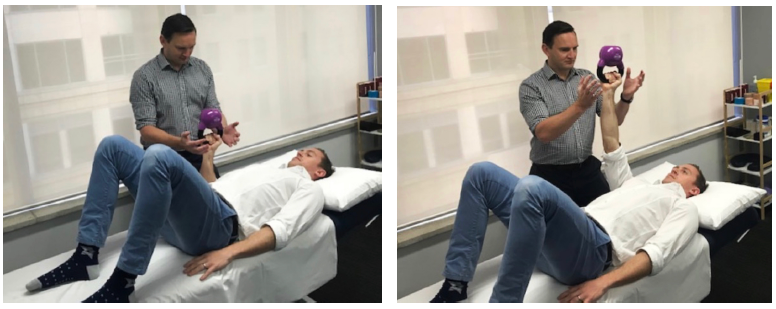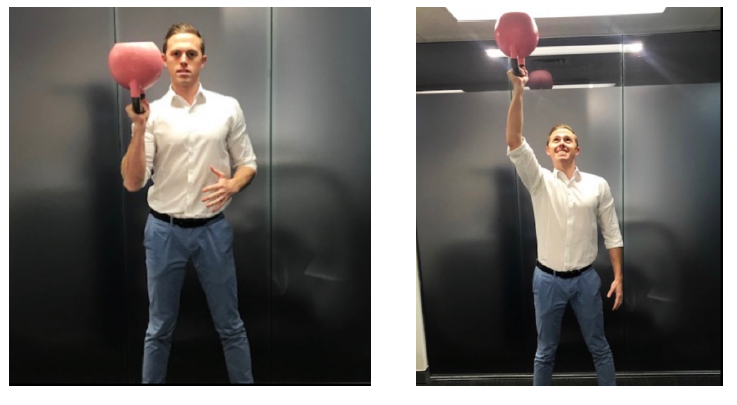To get the most out of our group fitness experience, we need to take the time and effort to
look after our joints. In this article, physiotherapist Jackson Toigo explores the relationship
between grip strength and shoulder function.
GRIP STRENGTH, THE ROTATOR CUFF, AND KETTLEBELLS
How to use grip strength to increase rotator cuff activity and improve shoulder
function
The simple task of gripping can have a great influence on the shoulder. Not only has it been shown to improve rotator cuff (RTC) activity, but also it may have an important role in injury prevention and recovery. Here are a few notes from New York based physical therapist and kettle bell expert Aaron Swanson. He has a great interest in movement patterns and summarises it well into 6 easy points.
The Grip-Shoulder Connection
Here are 6 ways the grip can influence the shoulder –
1) Neurological Connection of the Grip and the Rotator Cuff Many studies have shown a positive correlation between hand gripping activity and rotator cuff muscle activity (2-6). This correlation has been shown to be a result of a neurological connection through propriospinal pathways (1). An advantage of this mechanism is that it provides the shoulder with anticipatory stability in upper extremity tasks involving a gripping activity. Thus, upon manipulating an object your shoulder will be better prepared to handle the load efficiently.
2) Redistributes Muscle Activity of the Shoulder
Not only does gripping help to activate the RTC, but it decreases the activity of the anterior and middle deltoid (2,3,5,6). Most shoulder impingement patients suffer from an altered deltoid-RTC force couple where the deltoid’s superior force dominates the compressive, centrating forces of the RTC. Since gripping can increase RTC activity and decrease deltoid activity, it can be a very valuable exercise for impingement patients.
3) Irradiation
Irradiation has proven to be of great benefit in improving stability. Irradiation has been defined as “a spreading and increased strength of a response.”(7) Gripping can be used to increase the flow of neural drive to all of the muscles in the extremity. This can lead to increased stability and strength of the entire upper quarter.
4) Muscle Pump
For inflamed shoulders or shoulders that could benefit from increased blood flow and improved venous return, grip work provides a muscle pump similar to that of ankle pumps for knee patients.
5) Prevents Mechanical Compensation
Similar to pronation causing a proximal dynamic valgus in the lower extremity, a weak grip can cause proximal compensatory mechanisms in the elbow, shoulder, and/or cervical spine. A lack of stability in one segment will always be made up for by another.
6) Improves Grip Strength
Even at a local level, improving grip strength provides many benefits. A stronger grip can help to improve wrist function and may prevent injuries. This increased grip strength can make functional tasks such as carrying groceries, opening jars, and lifting objects much easier.
Assessment: ‘Bottoms-Up Kettlebell’
This kettlebell (KB) test is the blue-collar way to assess grip. This test is easy to perform, functional, provides great information regarding upper extremity stability and grip strength, and you also gain a good sense of your shoulder stability.
Whilst in hook-lying position (lying on your back with feet flat on the ground, and 60° flexion in the knees), your physio will have you flex your arm to 90 degrees, and will place a light KB in your hand (in the ‘bottoms-up’ position). The scapula should be in a neutral position and not protracted.
Your physio will guard the KB to provide support in case you begin to lose your grip, as you hold for 10-20 seconds. Your weight will then be progressed until you find a weight that is difficult to stabilise.
Once you understand the concept of grip strength and it’s influence on the shoulder, you can use it in an infinite amount of ways. Even if you don’t have kettlebells, you can simply use a towel, low compression tennis ball, or thera-bar (really anything you can grip circumferentially). If you do have kettlebells, then the door opens up to many different exercise progressions. But before you get carried away with Turkish get-ups, partial armbars, KB carries, waiters walks, and bottoms-up presses, you should start slow and develop the grip strength first.
Conclusion
Grip strengthening offers an easy way to augment shoulder stability. There are many
benefits from simply adding a gripping activity to upper extremity exercises. It’s easy to
both assess and implement.
For low-level patients the supine bottoms-up KB exercise offers a challenge that can activate the right muscle sequencing and improve stability. For more advanced patients it becomes a great warm up that can be integrated into more functional dynamic exercises.
References
1.Roberts LV, Stinear CM, Lewis GN, and Byblow WD. “Task-Dependent Modulation of
Propriospinal Inputs to Human Shoulder.” Journal of Neurophysiology 100.4 (2008):
2109-114.
2.Sporrong H, Palmerud G, Herberts P. Influences of handgrip on shoulder muscle
activity. Eur J Appl Physiol Occupat Physiol 71: 485–492, 1995.
3.Sporrong H, Palmerud G, Herberts P. Hand grip increases shoulder muscle activity: an
EMG analysis with static hand contractions in 9 subjects. Acta Orthop Scand 67:
485–490, 1996.
4.Sporrong H, Styf J. Effects of isokinetic muscle activity on pressure in the
supraspinatus muscle and shoulder torque. J Orthop Res 17: 546 –553, 1999.
5.Au AK, Keir PJ. Interfering effects of multitasking on muscle activity in the upper
extremity. J Electromyogr Kinesiol 2007;17:578–86.
6.Antony NT, Keir PJ. Effects of Posture, Movement and Hand Load on Shoulder Muscle
Activity. Journal of Electromyography and Kinesiology 20.2: 191-98. 2010.
7 Adler S, Beckers D, and Buck M. PNF in Practice: An Illustrated Guide. Berlin: Springer,
2000.



